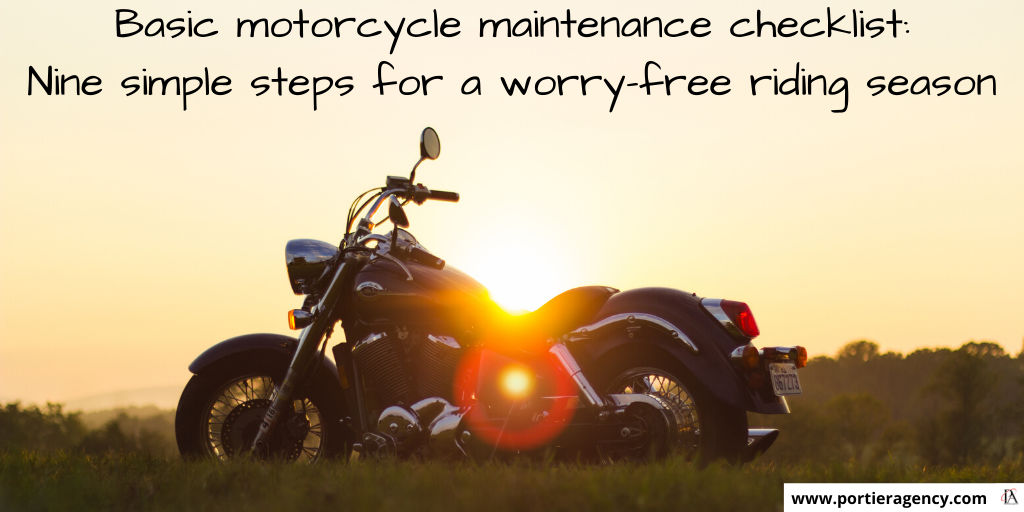Basic motorcycle maintenance checklist: Nine simple steps for a worry-free riding season

Basic motorcycle maintenance checklist:
Nine simple steps for a worry-free riding season
Before you tuck the kickstand up this spring, download our spiffy maintenance checklist and use it as a guide to give your bike a proper once-over.
It doesn’t take long, and the peace of mind you’ll get knowing you personally checked your machine from tip to tail will pay you back tenfold. Trust me, an hour in the garage now beats an hour on the side of the road troubleshooting or waiting for AMA roadside assistance.
If you keep up with the motorcycle maintenance schedule in your service manual (the number-one tool in your garage) and you did your due diligence when putting your bike away for winter, you’ll breeze through this list. But if you’re like most of us (myself included), you did a bit better than the bare minimum, got cold, and made yourself a grilled cheese. So go ahead, roll your sleeves up, and get busy with all the things you’ll need to get your motorcycle ready for spring.

1. Walkaround
It sounds almost stupid… but when is the last time you looked over each part of your bike? Everything on a vehicle wears gradually, making even completely gacked components sometimes difficult to notice in daily operation. Simply clicking your mindset into “spot anything unusual” mode can reveal issues that require attention — before they turn into real, ride-halting problems.
Look for leaks. Streaks of oil and dirt down fork lowers suggest failed fork seals. Drips under the bike must be investigated. Is that coolant? Oil? Fuel? Give it a sniff, then backtrack the source. If it’s been leaking for a while, you may have to de-gunk your bike’s nether regions to zero in on the origin.

Examine pivot points and moving parts for signs of wear or interference (kickstand pivots, swingarm and suspension linkages are almost universally neglected). Hit any zerk fittings with your grease gun until clean grease squeezes out the other end of the cavity, and note any bushings or bearings due for further investigation or replacement.
Turn the key. Test your lights and horn, and double check that your registration and insurance are current. Battery weak or dead? You’ll have to get the juice flowing again, then double back to check your signals.

2. Battery
If your battery’s been on a maintenance charger, it should be fully charged. If not, plug one in now. If the battery takes a full charge, that’s a good sign — but doesn’t guarantee it won’t crap out on you halfway through your first big ride of the season.
Probing with a multimeter can give you a pretty good picture of your battery’s overall health (you want to see over 12.5 V DC at the terminals, key off), but the choice of champions is a battery tester that can test cranking amps against the number you punch in from the CCA rating stickered on the battery. If you only have a multimeter, you can perform a few other tests besides just checking standing voltage at the terminals.
Without any fancy meters at all, you should still be able to get a good gauge on whether or not your battery is beginning to bite the dust by how easily it cranks your engine over and its age. The manufacture date can also be found on the sticker, and if yours is pushing five years, you may want to start thinking about replacement. It’s better to replace a battery on your terms than to be at the mercy of a shop or dealership, and potentially adding the cost of a tow to the repair bill (ask me how I know).
Clean your terminals, then coat with dielectric grease to prevent corrosion. This is also a good time to open up your fuse box and inspect your fuses. Remember to check your spares, and tuck a few extra in there if there’s room. A blown fuse is just about the most facepalm-ingly frustrating reason to have to get a bike towed.

3. Tires and wheels
The importance of tire condition cannot be overstated. We motorcyclists only get two (maybe three if you’re trikey), and the amount of trust required to lean into that first corner is tremendous. While age should be considered, it is by no means the only — and certainly not the most important — factor in determining a tire’s roadworthiness.
Despite the prevailing paranoia of zealous date-code checkers, motorcycle tires have a longer life expectancy than you might think. Tire manufacturers consider five years to be the “sell by” date, anticipating years of service after that. So if you get a new tire and find it was made a year or two prior, remember it’s still got its whole life ahead of it. On a machine that is regularly ridden, you will probably never see a set die of old age. Still, you’ll want to take the manufacture date into account as you examine the rubber for dry rot, cracks, or excessive hardening from oxidation.
A motorcycle tire’s most honorable death is also its most common: wear. If your tire has wear indicators, it should be easy to spot if it’s time for replacement when the wear bar (set in a sipe or groove) becomes flush with the surface of the tire. If you’re not sure, check remaining tread depth at the area of the tire that has seen the most wear (almost always the center). If you do need new tires, don’t forget fresh valve stems (or inner tubes) and balancing weights (if you plan to mount and balance yourself). Wheel weights can fall off — check that yours are in still in place. You’ll also want to check your wheel bearings, but first, you’ll need to get your wheels off the ground.

If you aren’t already invested in a lift, jack, or Pit Bull-style front and rear stand, you might consider a Bursig lift for the job. For about the same cost as front and rear stands or a hydraulic motorcycle jack, you can get an all-in-one, space-saving tool that can not only lift your whole motorcycle off the garage floor, but also […]
# # #
Continue reading this article.
Don’t forget, The Portier Agency offers:
homeowner/mobile home/ renter’s /automobile / motorcycle / life / commercial / crop insurance.
Call or come by to get your quote!
 The Portier Agency, LLC
The Portier Agency, LLC
113 North Irwin Avenue
Ocilla, GA 31774
229-468-3444
portieragency@windstream.net